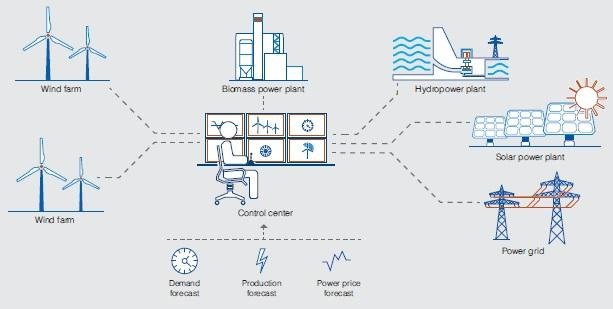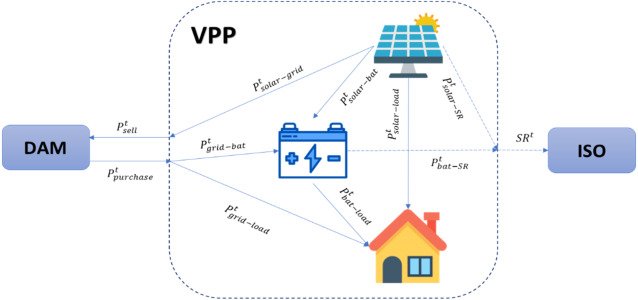Contents
ToggleProject: Virtual Power Plants on Netlogo
This mini project is part of the course carried out at ENSTA. This mini-project aims to produce, by constructive method, a simulation of Virtual Power Plants on the Netlogo software.

The report to be submitted is a compressed file including a PDF detailing each part as well as the Netlogo code for each part. It should be noted that observation parameters (graph, counter, etc.) are to be added in order to validate your comments. These parameters are not explained in the specifications.
Part 1: Grouping of small producers
A virtual power plant (VPP) is a combination of small energy sources (or available energy storage systems), which are activated and optimized by a computer system at the service of an electricity distribution operator. or purchase options from a producer external to the production company.
The objective of this first part is to lay the foundations for the training simulation of VPPs.
We consider three types of renewable energy production (solar, wind and other). Each type of plant has a low limit and a high production limit. When generating each element, its production is constant and is determined randomly between its low limit and high limit.
The elements seek to come together virtually in order to form clusters. The only condition for an element to be satisfied is that the production of its cluster exceeds a certain threshold. If the element is not satisfied, it will seek to associate elsewhere.

Each point must be argued separately:
- Define agents, observer parameters, setup and go.
- Explain the chosen model (how to group together, how an element can be satisfied, etc.).
- Carry out simulations
- What do you observe in a simulation (is this the desired behavior)?
- What do you observe in several simulations (is there always convergence)?
- What do you observe by changing the observer parameters (critical or cascading effects)?
Part 2: Geographical restriction
The elements are subject to topological restrictions. In other words, it is not possible for one element to associate with all the others due to geographic opposites, grid structure or even restrictions in energy markets.
Suggest to the observer to be able to create from 1 to 5 geographical zones. The elements can only be grouped together with elements having the same geographical area.

Each point must be argued separately:
- Explain how to model the geographic area parameter
- How to include this new parameter in the behavior of elements
- Carry out simulations
- What do you observe in a simulation (is this the desired behavior)?
- What do you observe in several simulations (is there always convergence)?
- What do you observe by changing the observer parameters (critical or cascading effects)?
Part 3: Limit of VPPs
It is not legally possible for elements to associate ad infinitum, there is a high production limit for VPPs (in reality, this limit is mostly due to network infrastructure, aggregators and better profitability of smaller VPPs).
Element satisfaction depends as much on the low limit and the high limit of the cluster they have joined. This upper limit is a parameter of the observer.

Each point must be argued separately:
- Explain how to model the high limit parameter
- How to include this new parameter in item satisfaction
- Carry out simulations
- What do you observe in a simulation (is this the desired behavior)?
- What do you observe in several simulations (is there always convergence)?
- What do you observe by changing the observer parameters (critical or cascading effects)?
Part 4: Production variability
The production of each element is not constant over time. It is therefore necessary to model the evolution of production.
At each tick, here is the evolution of the production of each type of power plant (taking into account the high and low production limit):
- Solar: up to plus or minus 3% variation
- Wind: up to plus or minus 1% variation
- Other: up to plus or minus 0.1% variation

Each point must be argued separately:
- Explain how to model production change
- Carry out simulations
- What do you observe in a simulation (is this the desired behavior)?
- What do you observe in several simulations (is there always convergence)?
- What do you observe by changing the observer parameters (critical or cascading effects)?
